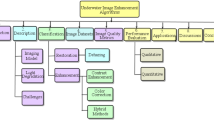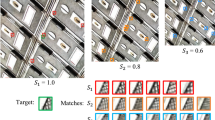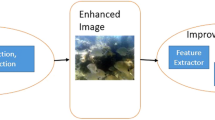Abstract
Haze is an obvious phenomenon in the underwater scenario. The scene visibility reduces to a great extent due to haze, which makes the underwater visual surveillance quite a challenging task. In this article, we have exploited the multi-resolution ability of discrete wavelet transform and applied dark channel prior based transmission map estimation scheme to dehaze the highly degraded underwater image and restored the color. A three-fold scheme for dehazing of underwater sequences is proposed. In the first stage, image details are extracted using discrete wavelet transform followed by image negative operation. In the second stage, the negative of detail images are enhanced by the help of dark channel prior. The third stage is used for reconstruction, where the enhanced image details are used along with the single level approximate of the input image to get the dehazed underwater image using inverse discrete wavelet transform. The proposed scheme is tested with numerous standard underwater images, as well as the excavation images of Dwaraka (Dvārakā) underwater ruins. The effectiveness of the proposed scheme is justified by comparing it with different state-of-the-art image dehazing techniques. The quantitative evaluation has been carried out using five well established general purpose non-reference image quality indices namely BIQI (blind image quality index), BLIINDS (BLind Image Integrity Notator using DCT Statistics), DIIVINE (Distortion Identification-based Image Verity and INtegrity Evaluation), BRISQUE (Blind/Referenceless Image Spatial Quality Evaluator), and SSEQ (Spatial-Spectral Entropy-based Quality). Encouraging scores of 35.01, 30.105, 27.22, 30.10, and 27.8, are achieved for the BIQI, BRISQUE, SSEQ, DIIVINE, and BLIINDS, respectively. Four evaluation measures, exclusively designed for underwater scenarios (underwater image quality, contrast, sharpness, and colorfulness measures) are also used to test the performance of the proposed scheme.











Similar content being viewed by others
References
Abas PE, De Silva LC et al (2019) Review of underwater image restoration algorithms. IET Image Process 13(10):1587–1596
Addison PS (2017) The illustrated wavelet transform handbook: Introductory theory and applications in science, engineering, medicine and finance. CRC Press, Boca Raton, Florida, USA
Agarwal S, Regentova EE, Kachroo P, Verma H (2017) Multidimensional compression of its data using wavelet-based compression techniques. IEEE Trans Intell Transp Syst 18(7):1907–1917
Ahn J, Yasukawa S, Sonoda T, Ura T, Ishii K (2017) Enhancement of deep-sea floor images obtained by an underwater vehicle and its evaluation by crab recognition. J Mar Sci Technol 22(4):758–770
Alex RS, Deepa S, Supriya M (2016) Underwater image enhancement using clahe in a reconfigurable platform. In: MTS/IEEE Monterey OCEANS, pp 1–5
Ancuti CO, Ancuti C (2013) Single image dehazing by multi-scale fusion. IEEE Trans Image Process 22(8):3271–3282
Ancuti CO, Ancuti C, De Vleeschouwer C, Bekaert P (2018) Color balance and fusion for underwater image enhancement. IEEE Trans Image Process 27(1):379–393
Antonini M, Barlaud M, Mathieu P, Daubechies I (1992) Image coding using wavelet transform. IEEE Trans Image Process 1(2):205–220
Anwar S, Li C (2020) Diving deeper into underwater image enhancement: a survey. Signal Process Image Commun 89:115978
Bickford D, Lohman DJ, Sodhi NS, Ng PK, Meier R, Winker K, Ingram KK, Das I (2007) Cryptic species as a window on diversity and conservation. Trends Ecol Evol 22(3):148–155
Boujelbene R, Jemaa YB, Zribi M (2019) A comparative study of recent improvements in wavelet-based image coding schemes. Multimed Tools Appl 78(2):1649–1683
Cai B, Xu X, Jia K, Qing C, Tao D (2016) DehazeNet: An end-to-end system for single image haze removal. IEEE Trans Image Process 25(11):5187–5198
Chen Z, Wang H, Shen J, Li X, Xu L (2014) Region-specialized underwater image restoration in inhomogeneous optical environments. Opt Int J Light Electron Opt 125(9):2090–2098
Cheng CY, Sung CC, Chang HH (2015) Underwater image restoration by red-dark channel prior and point spread function deconvolution. In: IEEE International conference on signal and image processing applications, pp 110–115
Chiang JY, Chen YC (2012) Underwater image enhancement by wavelength compensation and dehazing. IEEE Trans Image Process 21(4):1756–1769
Colores SS, Moya-Sánchez EU, Ramos-arreguín JM, Cabal-Yépez E (2019) Statistical multidirectional line dark channel for single-image dehazing. IET Image Process 13(14):2877–2887
Emberton S, Chittka L, Cavallaro A (2017) Underwater image and video dehazing with pure haze region segmentation. Comput Vis Image Underst 168:145–156
Fabbri C, Islam MJ, Sattar J (2018) Enhancing underwater imagery using generative adversarial networks. In: IEEE International conference on robotics and automation, pp 7159–7165
Gao Y, Hu HM, Wang S, Li B (2014) A fast image dehazing algorithm based on negative correction. Signal Process 103:380–398
Ghani ASA, Isa NAM (2017) Automatic system for improving underwater image contrast and color through recursive adaptive histogram modification. Comput Electron Agric 141:181–195
Goh Y, Teoh AB, Goh MK (2008) Wavelet based illumination invariant preprocessing in face recognition. In: IEEE Congress on image and signal processing, vol 3, pp 421–425
González-Rivero M, Bongaerts P, Beijbom O, Pizarro O, Friedman A, Rodriguez-Ramirez A, Upcroft B, Laffoley D, Kline D, Bailhache C et al (2014) The catlin seaview survey–kilometre-scale seascape assessment, and monitoring of coral reef ecosystems. Aquat Conserv: Mar Freshwat Ecosyst 24(S2):184–198
Haar A (1910) Zur theorie der orthogonalen funktionensysteme. Math Ann 69(3):331–371
Harris S, Ballard R (1986) Argo: Capabilities for deep ocean exploration. In: IEEE OCEANS, pp 6–8
Hassan N, Ullah S, Bhatti N, Mahmood H, Zia M (2021) The retinex based improved underwater image enhancement. Multimed Tools Appl 80 (2):1839–1857
He K, Sun J, Tang X (2011) Single image haze removal using dark channel prior. IEEE Trans Pattern Anal Mach Intell 33(12):2341–2353
Hsia CH, Chiang JS, Guo JM (2012) Memory-efficient hardware architecture of 2-D dual-mode lifting-based discrete wavelet transform. IEEE Trans Circuits Syst Video Technol 23(4):671–683
Hsia CH, Guo JM, Chiang JS (2009) Improved low-complexity algorithm for 2-D integer lifting-based discrete wavelet transform using symmetric mask-based scheme. IEEE Trans Circuits Syst Video Technol 19(8):1202–1208
Hussein R, Shaban KB, El-Hag AH (2015) Wavelet transform with histogram-based threshold estimation for online partial discharge signal denoising. IEEE Trans Instrum Meas 64(12):3601–3614
J M, K P (2012) Performance comparison of PCA, DWT-PCA and LWT-PCA for face image retrieval. Comput Sci Eng 2(6):41–50
Jaffe JS (2015) Underwater optical imaging: The past, the present, and the prospects. IEEE J Ocean Eng 40(3):683–700
Ju M, Ding C, Zhang D, Guo YJ (2018) BDPK: Bayesian Dehazing using prior knowledge. IEEE Trans Circuits Syst Video Technol 29(8):2349–2362
Lee D, Kim G, Kim D, Myung H, Choi HT (2012) Vision-based object detection and tracking for autonomous navigation of underwater robots. Ocean Eng 48:59–68
Li J, Skinner KA, Eustice RM, Johnson-Roberson M (2018) WaterGan: Unsupervised generative network to enable real-time color correction of monocular underwater images. IEEE Robot Autom Lett 3(1):387–394
Liu L, Liu B, Huang H, Bovik AC (2014) No-reference image quality assessment based on spatial and spectral entropies. Signal Process Image Commun 29(8):856–863
Lu H, Li Y, Serikawa S (2015) Single underwater image descattering and color correction. In: IEEE International conference on acoustics, speech and signal processing, pp 1623–1627
Mallat SG (1989) A theory for multiresolution signal decomposition: The wavelet representation. IEEE Trans Pattern Anal Mach Intell 11(7):674–693
Mittal A, Moorthy AK, Bovik AC (2012) No-reference image quality assessment in the spatial domain. IEEE Trans Image Process 21(12):4695–4708
Moorthy AK, Bovik AC (2010) A two-step framework for constructing blind image quality indices. IEEE Signal Process Lett 17(5):513–516
Moorthy AK, Bovik AC (2011) Blind image quality assessment: From natural scene statistics to perceptual quality. IEEE Trans Image Process 20 (12):3350–3364
Naik DK, Rout DK (2014) Outdoor image enhancement: Increasing visibility under extreme haze and lighting condition. In: IEEE International advance computing conference, pp 1081–1086
Nikan S, Ahmadi M (2014) Local gradient-based illumination invariant face recognition using local phase quantisation and multi-resolution local binary pattern fusion. IET Image Process 9(1):12–21
Nishino K, Kratz L, Lombardi S (2012) Bayesian defogging. Int J Comput Vis 98(3):263–278
Olszewska JI (2013) Multi-scale, multi-feature vector flow active contours for automatic multiple-face detection. In: Proceedings of the 6th international conference on bio inspired systems and signal processing, pp 429–435
Ortega A, Jiang W, Fernandez P, Chrysafis CG (1999) Implementations of the discrete wavelet transform: Complexity, memory, and parallelization issues. In: Wavelet applications in signal and image processing VII, vol 3813, pp 386–400
Pan PW, Yuan F, Cheng E (2018) Underwater image de-scattering and enhancing using dehazeNet and HWD. J Mar Sci Technol 26(4):531–540
Panetta K, Gao C, Agaian S (2015) Human-visual-system-inspired underwater image quality measures. IEEE J Ocean Eng 41(3):541–551
Pereira DA, Fraza O et al (2004) Fiber bragg grating sensing system for simultaneous measurement of salinity and temperature. Opt Eng 43 (2):299–304
Priyadharsini R, Sharmila TS, Rajendran V (2018) A wavelet transform based contrast enhancement method for underwater acoustic images. Multidim Syst Sign Process 29(4):1845–1859
Qiao X, Bao J, Zhang H, Zeng L, Li D (2017) Underwater image quality enhancement of sea cucumbers based on improved histogram equalization and wavelet transform. Inf Process Agric 4(3):206–213
Rout DK, Subudhi BN, Veerakumar T, Chaudhury S (2018) Spatio-contextual gaussian mixture model for local change detection in underwater video. Expert Syst Appl 97:117–136
Saad MA, Bovik AC, Charrier C (2010) A DCT statistics-based blind image quality index. IEEE Signal Process Lett 17(6):583–586
Sahu G, Seal A, Krejcar O, Yazidi A (2021) Single image dehazing using a new color channel. J Vis Commun Image Represent 103008:74
Serikawa S, Lu H (2014) Underwater image dehazing using joint trilateral filter. Comput Electr Eng 40(1):41–50
Shahbahrami A (2012) Algorithms and architectures for 2D discrete wavelet transform. J Supercomput 62(2):1045–1064
Singh H, Adams J, Mindell D, Foley B (2000) Imaging underwater for archaeology. J Field Archeol 27(3):319–328
Song W, Wang Y, Huang D, Liotta A, Perra C (2020) Enhancement of underwater images with statistical model of background light and optimization of transmission map. IEEE Trans Broadcast 66(1):153–169
Souaidi M, El Ansari M (2019) Multi-scale analysis of ulcer disease detection from wce images. IET Image Process 13(12):2233–2244
Srivastava V, Purwar RK (2017) A five-level wavelet decomposition and dimensional reduction approach for feature extraction and classification of mr and ct scan images, vol 2017
Stark JA (2000) Adaptive image contrast enhancement using generalizations of histogram equalization. IEEE Trans Image Process 9(5):889–896
Sweldens W (1998) The lifting scheme: A construction of second generation wavelets. SIAM J Math Anal 29(2):511–546
Temple SE (2007) Effect of salinity on the refractive index of water: considerations for archer fish aerial vision. J Fish Biol 70(5):1626–1629
Twardowski MS, Boss E, Macdonald JB, Pegau WS, Barnard AH, Zaneveld JRV (2001) A model for estimating bulk refractive index from the optical backscattering ratio and the implications for understanding particle composition in case I and case II waters. J Geophys Res 106(C7):14129–14142
Vasamsetti S, Mittal N, Neelapu BC, Sardana HK (2017) Wavelet based perspective on variational enhancement technique for underwater imagery. Ocean Eng 141:88–100
Wang B, Zheng F, Li X, Zhang S (2019) Single image dehazing using manifold particle filter. In: 12Th international congress on image and signal processing, biomedical engineering and informatics, pp 1–6
Wood R, Olszewska JI (2012) Lighting-variable adaboost based-on system for robust face detection. In: Proceedings of the 5th international conference on bio-inspired systems and signal processing, pp 494–497
Yassin AA, Ghadban RM, Saleh SF, Neima HZ (2013) Using discrete wavelet transformation to enhance underwater image. Int J Comput Sci Issues 10 (5):220–228
Yu H, Li X, Lou Q, Lei C, Liu Z (2020) Underwater image enhancement based on dcp and depth transmission map. Multimed Tools Appl 79(27):20373–20390
Zervas ND, Anagnostopoulos GP, Spiliotopoulos V, Andreopoulos Y, Goutis CE (2001) Evaluation of design alternatives for the 2-d-discrete wavelet transform. IEEE Trans Circuits Syst Video Technol 11(12):1246–1262
Zhang W, Dong L, Zhang T, Xu W (2021) Enhancing underwater image via color correction and bi-interval contrast enhancement. Signal Process Image Commun 116030:90
Zhu Q, Mai J, Shao L (2015) A fast single image haze removal algorithm using color attenuation prior. IEEE Trans Image Process 24(11):3522–3533
Zhuang P, Ding X (2020) Underwater image enhancement using an edge-preserving filtering retinex algorithm. Multimed Tools Appl 79(25):1–21
Acknowledgments
The authors would like to thank the Marine Archaeological Unit (MAU) of The Archaeological Survey of India (ASI), Dr. S. R. Rao, Mr. H. S. Adwani, Mr. M. A. Raveendra, Dr. Nalini Rao, Mr. Graham Hancock, and Mr. Rafal Reyzer for providing the Dwaraka sequence and images used in this article.
Author information
Authors and Affiliations
Corresponding author
Additional information
Publisher’s note
Springer Nature remains neutral with regard to jurisdictional claims in published maps and institutional affiliations.
Appendix: Evaluation Measures
Appendix: Evaluation Measures
Quantitative analysis of the images is carried out using the non-reference image quality assessment measures. The reason for choosing these measures is that, in our experiments, the reference or ground truth images are not available.
- BRISQUE :
-
[38]: It is a natural scene statistic based distortion-generic blind/no-reference image quality assessment model which operates in the spatial domain. It uses scene statistics of locally normalized luminance coefficients to quantify possible losses of ‘naturalness’ in the images due to the presence of distortions, thereby leading to a holistic measure of quality. A support vector regression (SVR) model is employed by using the differential mean opinion score (DMOS) value. The measure is based on the mean subtracted contrast normalized (MSCN) coefficient, which is given by;
$$ I_{MSCN} = \frac{I(i,j)-\mu(i,j)}{\sigma(i,j)+c}, $$(24)where,
$$ \mu(i,j)={\sum}_{k=-K}^{K}{\sum}_{l=-L}^{L}w_{k,l}I(i+k,j+l), $$(25)$$ \sigma(i,j)=\sqrt{{\sum}_{k=-K}^{K}{\sum}_{l=-L}^{L}w_{k,l}\left[I(i+k,j+l)-\mu(i,j)\right]^{2}}. $$(26) - DIIVINE :
-
[40]: It is a distortion-agnostic approach to blind image quality assessment that utilizes concepts from natural scene statistics to not only quantify the distortion but also quantify the distortion type afflicting the images. First, it computes the wavelet coefficients and normilize them. Next, it identifies the distortion afflicting the images and then performs the distortion-specific quality assessment.
- BLIINDS :
-
[52]: It is an efficient, general-purpose, non-distortion specific, blind/no-reference image quality assessment algorithm that uses discrete cosine transform coefficients to perform the distortion-agnostic quality assessment.
- BIQI :
-
[39]: It is a new two-step framework for no-reference image quality assessment based on natural scene statistics. Once trained, the framework does not require any knowledge of the distorting process and the framework is modular so it can be extended to any number of distortions.
- SSEQ :
-
[35]: It is an efficient general-purpose no-reference image quality assessment model that utilizes local spatial and spectral entropy features on distorted images. It Uses a 2-stage framework of distortion classification followed by a quality assessment. It utilizes a support vector machine to train an image distortion and quality prediction engine. It is capable of assessing the quality of a distorted image across multiple distortion categories.
- UICM :
-
[47]: This parameter is devised to measure the colorfulness of the image. This is given as;
$$ UICM = -0.0268 \sqrt{\mu_{\alpha, RG}^{2}+\mu_{\alpha, YB}^{2}}+0.1586 \sqrt{\sigma_{\alpha, RG}^{2}+\sigma_{\alpha, YB}^{2}}, $$(27)where μ represents the chrominance intensity, and σ2 represents the variance in the chrominance.
- UISM :
-
[47]: The underwater image sharpness measure aims to compute the measure of sharpness of an image. It is computed by;
$$ UISM = {\sum}_{c=1}^{3}\lambda_{c} EME \left( GrayscaleEdge_{c}\right), $$(28)$$ EME = \frac{2}{k_{1}k_{2}}{\sum}_{l=1}^{k_{1}}{\sum}_{k=1}^{k_{2}}log\left( \frac{I_{max,k,l}}{I_{min,k,l}}\right), $$(29)where k1k2 is the number of blocks an image got divided by.
- UIConM :
-
[47]: It is the underwater image contrast measure, which is defined mathematically as;
$$ UIConM = logAMEE(Intensity), $$(30)where the AMEE is the Agaian measure of enhancement by engropy. This is the average michaelson contrast in the local regions.
- UIQM :
-
[47]: It is the normalized underwater image quality measure. It is given by:
$$ UIQM = c_{1} \times UICM + c_{2} \times UISM + c_{3} \times UIConM, $$(31)where c1, c2, and c3 are the contributing factors which are set to 0.0282, 0.2953, and 3.5753, respectively.
Rights and permissions
About this article
Cite this article
Rout, D.K., Subudhi, B.N., Veerakumar, T. et al. Multiresolution visual enhancement of hazy underwater scene. Multimed Tools Appl 81, 32907–32936 (2022). https://doi.org/10.1007/s11042-022-12692-8
Received:
Revised:
Accepted:
Published:
Issue Date:
DOI: https://doi.org/10.1007/s11042-022-12692-8




